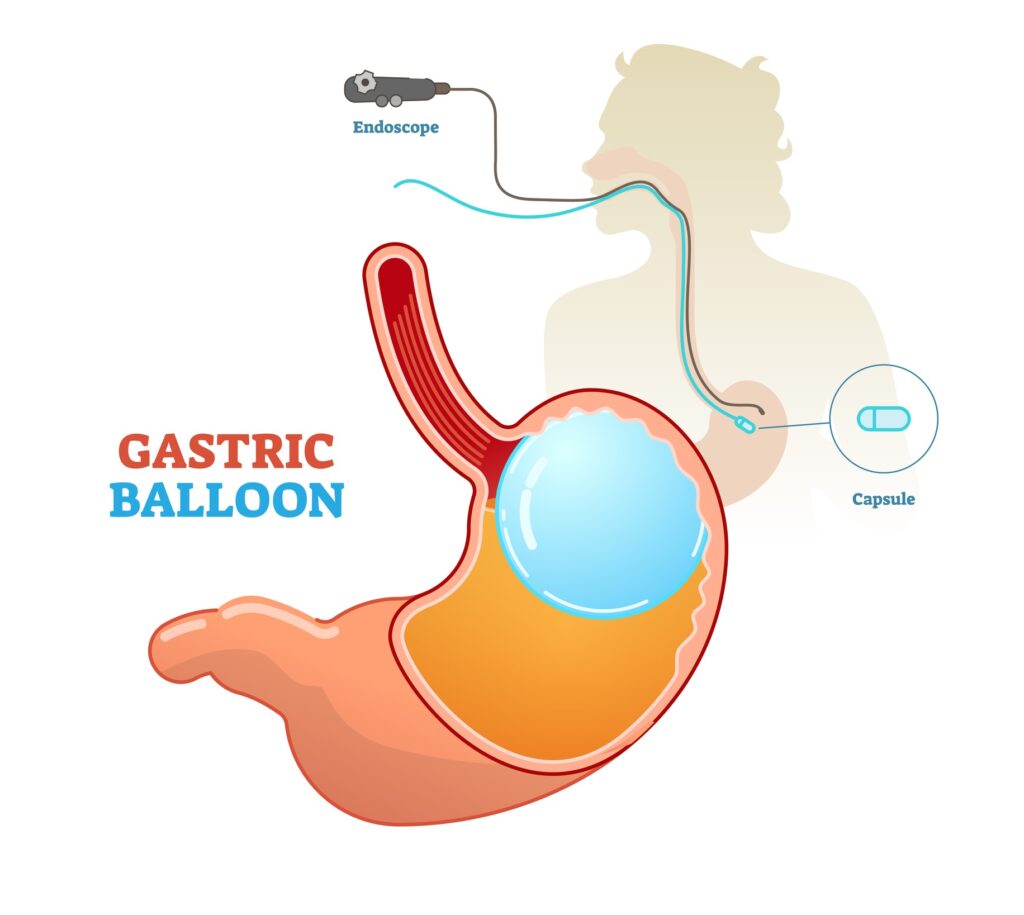Obesity is a serious health issue affecting more than one-third of Americans. It affects mobility, impacts self-esteem and increases the risk of many causes of preventable death—including type 2 diabetes, stroke, heart disease and some types of cancer. In addition, obesity raises medical costs by an average of $1,429 per patient per year.
In light of the above, the need for available and effective weight loss options is apparent. While some patients have had success with weight loss surgery, this requires an invasive procedure and a hospital stay, and thus is not appropriate for everyone.
As a newer and more appealing weight loss option, the weight loss balloon has helped patients lose a significant amount of weight in both the short term and the long term. When paired with a diet and exercise program, this simple procedure has proven effective in not only kick-starting but maintaining weight loss.

What is a weight loss balloon system?
The Obalon weight loss balloon system has been approved by the U.S. Food and Drug Administration and combines a medical procedure with nutritional and exercise support. With the weight loss balloon supplementing healthy lifestyle changes, patients can achieve safe, healthy and lasting weight loss.
The weight loss balloon system consists of three capsules, each of which contains an inflatable balloon attached to a catheter. For an idea of just how small these balloons are, they weigh less than a penny and are about the size of a small orange. The system requires three different sessions at the doctor’s office. No anesthesia is required as patients will swallow one capsule at a time, two weeks apart. The balloons are expected to stay in place for six months after insertion.
After placing a capsule, the doctor will take an X-ray to ensure correct positioning. Next, gas will be pumped through the catheter to fill up the balloon. Placement takes about 10 minutes and does not require sedation, meaning patients can usually resume their normal activities right away.
After the six-month treatment period, the weight loss doctor will perform an outpatient procedure to remove the balloons one at a time using an endoscope (a flexible tube with a tiny camera on the end). Deflating and removing the Obalon balloons is a simple, non-surgical procedure that only takes about 15 minutes and requires light sedation.
How does the weight loss balloon system cause weight loss?
The core concept of the weight loss balloon system is the idea that because the inflated balloons take up space in the stomach, patients can eat less and still feel full. However, while this is an important aspect of the weight loss process, it’s not the only one.
For instance, patients will need to meet with a nutritionist who will help them identify and implement necessary changes to their eating habits. They’ll also receive the support they need to start, maintain or enhance an exercise program appropriate for their age, fitness level, etc.
In conjunction with the weight loss balloon system, these lifestyle changes will jump-start patients’ short-term weight loss and set them up to maintain long-term success.
How does the weight loss balloon system compare to invasive procedures?
The weight loss balloon system’s simplicity and non-invasiveness contrast with higher-risk and more invasive surgical weight loss procedures that require a longer recovery period, including the following:
Vertical sleeve gastrectomy
- While the patient is under general anesthesia, the doctor places a tiny camera in the patient’s belly and makes incisions through which to pass instruments.
- The doctor removes a large portion of the stomach and staples together the remainder.
- The sleeve gastrectomy can be a same-day procedure, but may require a one-night stay in the hospital.
- Because this procedure interferes with the body’s ability to absorb vitamins, the patient must take vitamins for the rest of their life to avoid vitamin deficiency and serious complications.
Gastric bypass
- While the patient is under general anesthesia, the surgeon uses staples to divide the stomach into two sections, then creates a connection to the small intestine through a tiny hole in the smaller stomach section.
- If the surgeon makes smaller cuts, a less-invasive laparoscopic procedure can be used that requires a one- to two-day hospital stay. The patient can expect to resume regular activities in three to five weeks.
- The patient must take vitamins for the rest of their life to avoid vitamin deficiency and serious complications.
Duodenal switch
- The switch involves two surgical techniques that reduce the size of the patient’s stomach and rearrange the small intestine.
- These procedures can be done at the same time or staged and done at separate operations, with the second occurring six to 18 months after the first.
- The patient will stay in the hospital for one to three days following surgery.
- Increased bowel movements, diarrhea and foul-smelling stools or flatulence can occur following surgery.
- The patient must take vitamins for the rest of their life to avoid vitamin deficiency and serious complications.
What are the benefits of the weight loss balloon procedure?
The advantages of balloon weight loss surgery include:
Appropriate for more people – For patients affected by the BMI restrictions associated with more invasive types of weight loss surgery, using the weight loss balloon system may qualify them for further procedures.
Proven results – Studies have shown that the weight loss balloon system works. In one trial, obese patients who used the balloon system lost significantly more weight than their counterparts in the placebo group; specifically, balloon system patients lost 6.8 percent of their body weight after six months and continued to see results thereafter. Meanwhile, participants in another study who used the weight loss balloon system lost twice as much weight as those who relied on diet and exercise alone.
Better than older balloon systems – Although older balloon systems help patients lose weight within the first three months, results trail off significantly after that. Moreover, patients are required to take anti-nausea and anti-spasmodic medication, which can be a significant deterrent.
Non-invasive – Since the installation and removal of the balloon system do not involve incisions or breaking of the skin, the procedure is considered non-invasive.
No hospital stay – As detailed above, more invasive surgical weight loss procedures usually require patients to spend one to several nights in the hospital.
Lower risk of complications – The numerous potential complications associated with overnight hospital stays and general anesthesia are avoided with use of the weight loss balloon system. Even the removal procedure (i.e. the most intensive part of the process) requires only light anesthesia and takes about 15 minutes.
No downtime – After undergoing a weight loss balloon procedure, patients can immediately resume their normal routines and activities.
Less expensive – Without general anesthesia, a hospital stay and the possibility of needing to take time off work, it’s no wonder weight loss balloon surgery is less expensive than other weight loss procedures.
Emphasis on long-term results – Since patients are required to follow a diet and exercise plan in conjunction with the weight loss balloon procedure, they’ll be making long-term changes to the way they live. In one study, the balloon system helped patients maintain 89 percent of the weight loss they’d achieved in six months after a year.
Who is a good candidate for weight loss balloons?
Generally, a good candidate for this procedure is at least 22 years old and has a BMI of 30 to 40. Patients will also need to commit to the six-month program and be willing to follow a diet and exercise regime during that time and beyond.
The program also requires a financial commitment, as the weight loss balloon system can cost between $6,000 and $9,000 (including balloon removal and nutritional support).
Although weight loss balloons are a viable solution for many patients, they should be avoided under the following circumstances:
- Pregnancy or nursing
- Difficulty swallowing
- Daily use of prescription aspirin, anti-inflammatory drugs or blood thinners
- Prior surgeries or a condition that narrow or blocks the gastrointestinal tract
- Prior lap band or gastric sleeve surgery
- History of stomach disorders such as gastric ulcers, a large hiatal hernia or cancer
- History of irritable bowel disease or Crohn’s disease
- Allergic reactions to pig products
- Presence of an eating disorder
To find out more about the weight loss balloon system, make an appointment with BMI of Texas today. Our expert team will give you the information you need to make the best possible decision about the weight loss procedures you’re considering. We know that a one-size-fits-all approach to weight loss doesn’t work, so we’ll help you evaluate the options with your unique circumstances in mind.


